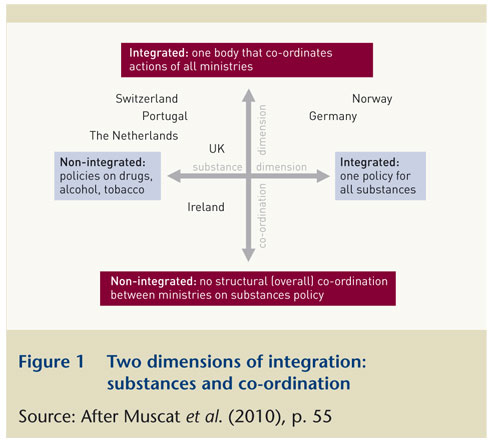Pike, Brigid
(2011)
Merging policies on psychoactive substances.
Drugnet Ireland,
Issue 39, Autumn 2011,
pp. 8-9.
In 2007 the Council of Europe’s Pompidou Group (PG), whose core mission is to contribute to the development of effective and evidence-based drug policies in member states, started an enquiry into how policy on different psychoactive drugs is organised in different countries. The PG has now published two reports on its investigation and is embarking on a third phase. Ireland is one of seven countries that the Pompidou Group is studying in depth.
The first phase of the investigation revealed that policies on psychoactive substances in 17 Council of Europe member states lay along a continuum between an integrated substance-use policy at one end and separate policies for different substances at the other end.1 Ireland was found to lie near the midway point, with three separate policies for illicit drugs, alcohol and tobacco, but a tendency to combine elements of illicit drugs and alcohol policy and practice.2
This preliminary investigation led to two recommendations – (1) develop a global policy framework for psychoactive substances within the context of health, and (2) improve the use of research evidence in policy making.2 These conclusions influenced the direction and shape of the second phase of the PG’s enquiry, the results of which were published in November 2010 and are briefly outlined below.3
Evidence from ‘social cognitive neural science’
In the first part of the new report, Richard Muscat, professor of behavioural neuroscience at the University of Malta, reviews the contribution of scientific evidence to policy making. Having outlined how epidemiological research over several decades has helped to determine the size of the problem associated with the use of psychoactive substances and its impact on society, he describes how biomedical research, including the emerging discipline of social cognitive neural science,4 is now improving our understanding of why people use psychoactive substances, why some users go on to become addicted/dependent, and how this new research evidence could help to improve the efficacy of policy making in the area of psychoactive substances.
Muscat describes the research evidence for how individual substances, including alcohol, tobacco, marihuana, cocaine, amphetamines, ecstasy, heroin, methadone and buprenorphine, affect the functioning of the brain and the consequences for the brain’s reward system (which influences behaviour), learning and memory, and decision making. He goes on to discuss the evidence for how addiction/dependence develops, looking at recent research on the contribution of neural processes, psychiatric disorders, genetic predisposition, psychological traits and sociological determinants.
Providing clearer insights into what determines our health and well-being, social cognitive neural science can, Muscat suggests, significantly improve policy making in the area of prevention, harm reduction and treatment for problems associated with a wide range of psychoactive substances. For example, a prevention campaign could target youngsters with specific psychological traits such as sensation seeking, which guides their decision making. With regard to harm reduction, Muscat observes that policy interventions are only adopted at national level after the measures have been found to work on the ground; he suggests that this pattern should be reversed ‘because policy makers should take cognisance of current scientific evidence earlier on’.
‘Integrating’ policies on psychoactive substances
In the second part of the report, Dike van de Mheen and Cas Barendregt of the Addiction Research Institute in the Netherlands report on an empirical investigation into (1) what the term ‘integrated policy’ means in seven countries chosen for study, including Ireland, and (2) how ‘integrated policy’ has been operationalised in these countries.A ‘short open questionnaire’ to elicit information on these two research questions was sent to one or two national experts in each country for completion, and was followed up by telephone interviews with the national experts.
A key finding is that the concept of ‘integration’ is highly nuanced. In order to ensure effective policy structures, it is essential to understand the nuances. To begin with, integration may refer to the combination of a variety of psychoactive substances in the one substance misuse policy. Alternatively, it may refer to the co-ordination of policies and actions in different government departments through a formal co-ordinating mechanism. Ireland is unique among the seven countries investigated as part of the study in having separate policies on drugs, alcohol and tobacco and not having any formal integrated structure for co-ordinating policies on psychoactive substances (Figure 1).

Underlying these two structural forms of integration is the possible integration of ideas (politics) and action (policy). The authors explain:
If the idea is that the consumption of psychoactive substances, other than tobacco or alcohol, is sinful or bad it may lead to prohibition of these substances. If the dominant idea is that legal and illegal substances can be viewed as potentially damaging to health, a health approach to psychoactive substances comes into focus. Co-ordination of health-oriented interventions requires a different policy infrastructure from a merely prohibitionist approach. (p. 57)
What are the best structures to ensure ‘coherent’ drug policies?
The next phase of the PG enquiry will seek to develop a model to test the ‘coherence’ of policies on substance misuse, in other words the extent to which the different modes of integration are compatible, the extent to which the political and policy approaches are aligned. This approach does not presuppose the superiority of any particular policy framework.
1. Muscat R and members of the Pompidou Group Research Platform (2008) From a policy on illegal drugs to a policy on psychoactive substances. Strasbourg: Council of Europe Publishing.
2. See Pike B (2009)Illicit drugs, alcohol and tobacco – understanding the policy issues. Drugnet Ireland, (29): 3–4.
3. Muscat R, van de Mheen D, Barendregt C and members of the Pompidou Group Research Platform (2010) Towards an integrated policy on psychoactive substances: a theoretical and empirical analysis. Strasbourg: Council of Europe Publishing.
4. Muscat defines the new discipline as including elements of sociology, cognitive psychology and neuroscience.
